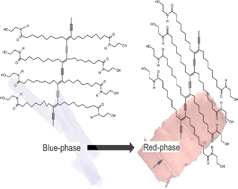Structural effect of polymerisation and dehydration on bolaamphiphilic polydiacetylene assemblies
Abstract
Polydiacetylenes (PDAs) undergo chromic responses to a range of environmental stimuli including temperature, pH and mechanical stress. A novel bolaamphiphilic diacetylene lipid has been synthesized and suspended in aqueous solution as polymerisable micrometer scale assemblies. Fourier transform infrared (


 Please wait while we load your content...
Please wait while we load your content...